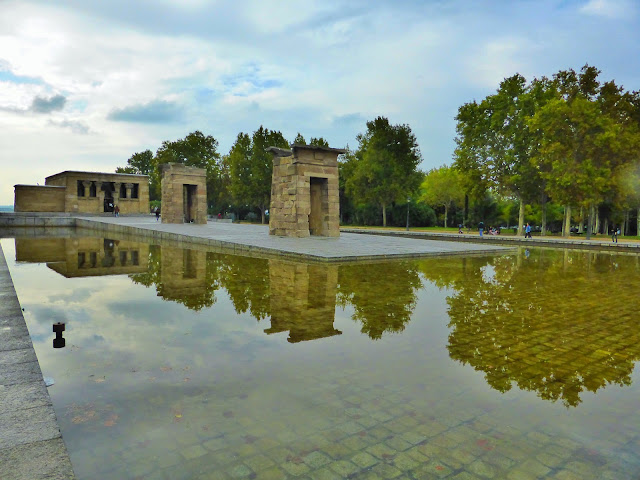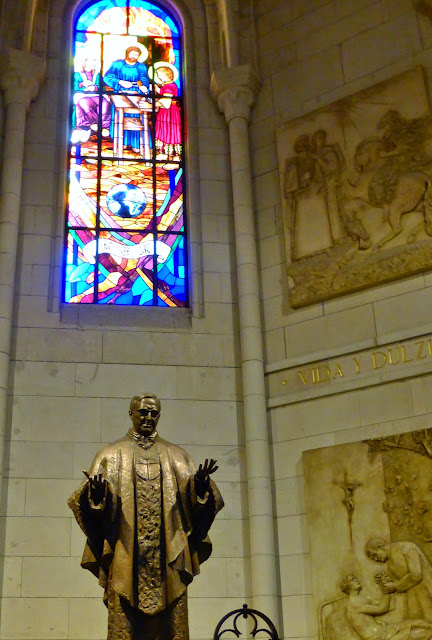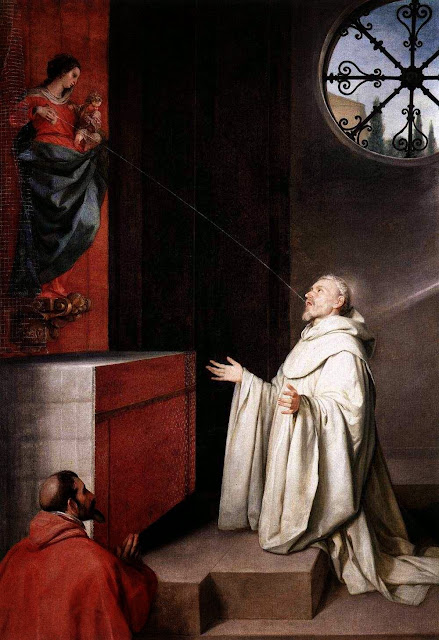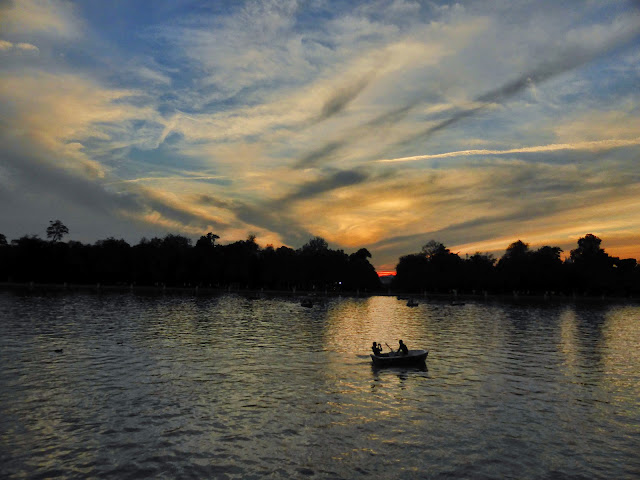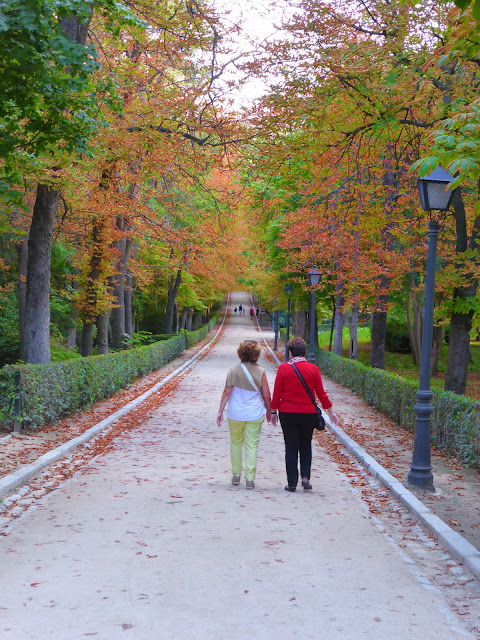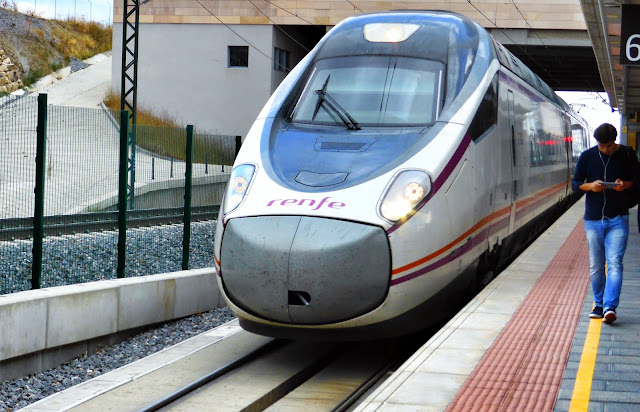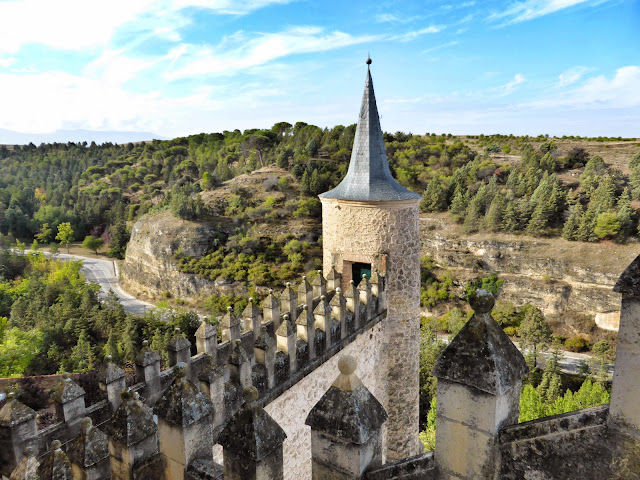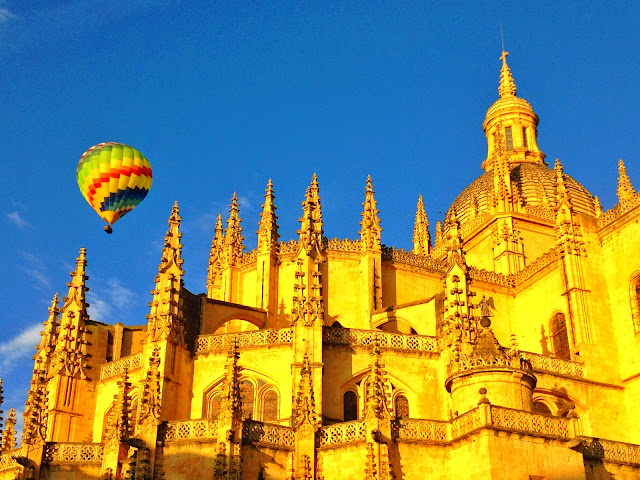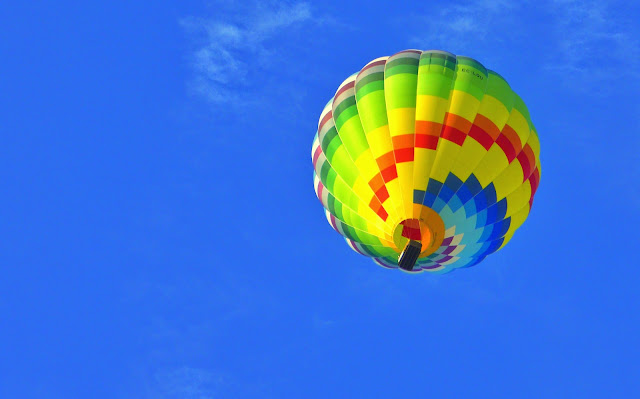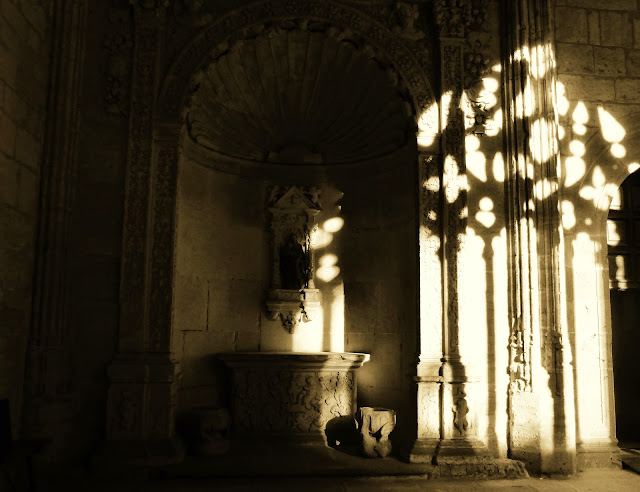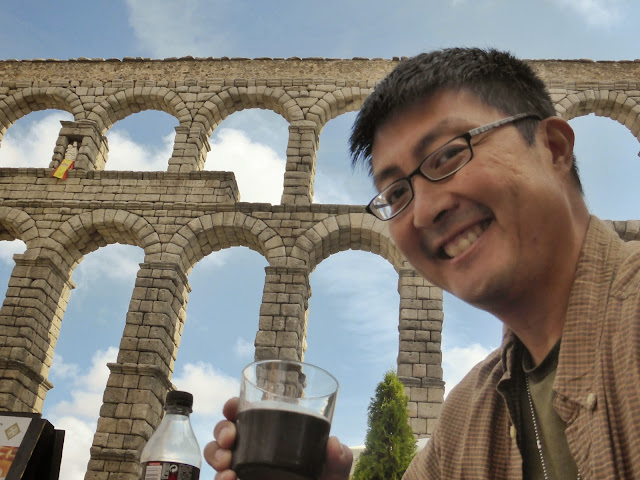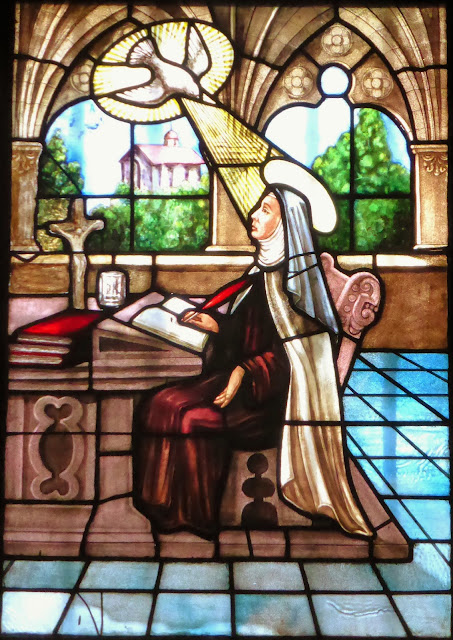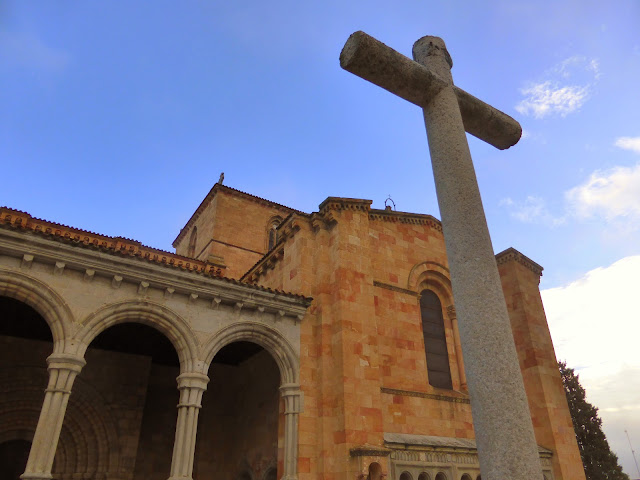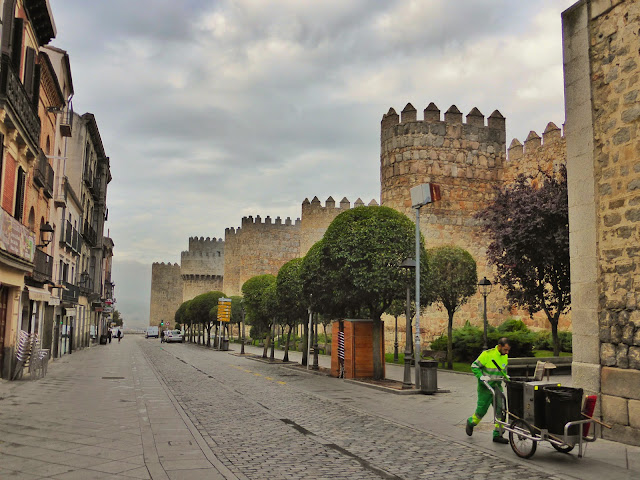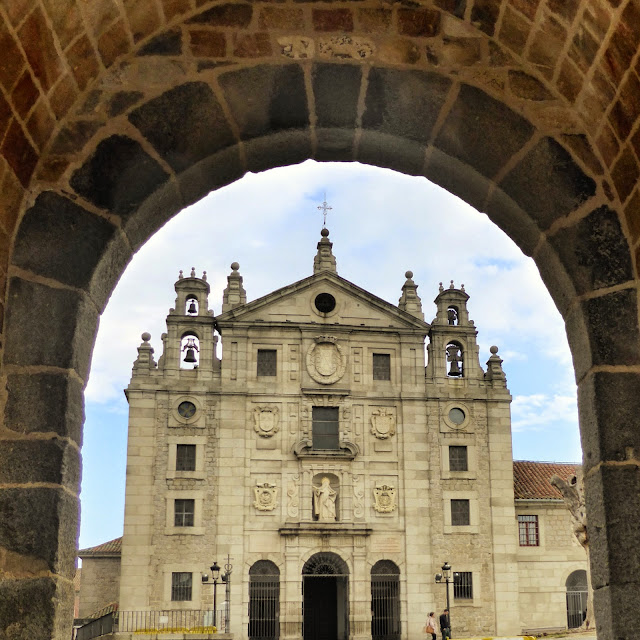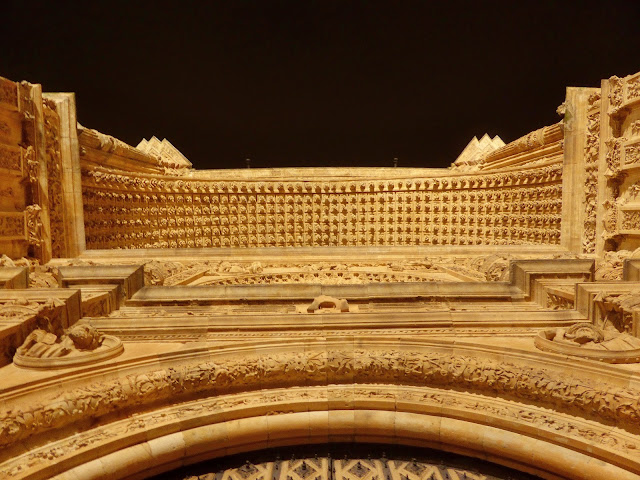I'm not sure I like Halloween as a sexy, alcohol-dripping festival for adults. It seemed more fun when it was in that transition time during the 60s-80s. When I see old 1950s references to Halloween, it seemed mostly for children. Then, at some point, Halloween started to become a time when you as an adult were allowed to feel childlike glee in costume.
Now, with sexy nurse costumes for kids it seems like it's flat out backwards. Halloween is when children are not just dressed up like adults, but are mimicking their party behaviors. And adults seem to think of it as an opportunity not feel like a child, but to act like one, trying to relive a childhood or frat party long gone.
Maybe the key is transition time. I like the transition time. And, like Halloween, it's also the scariest time. Transition is terrifying. You're never sure what comes out the other side. You hope, dream, aspire for something special and better but there's always the risk of a nightmare.
It's why when we approach the end of our time on earth, we fear the reaper. We don't know what to expect and fear what must come.
But with All Saints Day, All Souls Day, Halloween - the Dias de los Muertos time - we once again celebrate the transition. It's a thin space where past meets future, life greets the grave, humor shakes hands with fright.
I like most am leery of transition. But perhaps as one of those annoyingly optimistic ENFP types, I also carry in my heart a hope and eagerness to see what is on the other side. And, while here in the present, hope to see the shimmering glimmer of what might yet be.
Much has changed this past year. I've said goodbye to my brother in law, gotten married, walked the Camino de Santiago, moved out of my office to work from home, and paid respects to friends and family. I've watched people get hurt and hurt in return. I've held the hands of those who I may not see again for years to come or ever again.
All are times when you have to breathe and take things one step at a time, moment by moment, day by day. And yet in them there is hope that the thin space between yesterday and tomorrow will yield an insight and love that surpasses what we understand today. And who knows? Maybe I won't like where things end up. But until then, we can listen, enjoy, and grow together.
This time of thin space may be unsettling, but for me, it's the time of my life.
Mel's Healing Pilgrimage 2016
Links to the Camino de Santiago pilgrimages are on the navigation links to the right of the web page.
Friday, October 31, 2014
Thin space-time
Tuesday, October 28, 2014
Remembering Those Who Walked Before Us to Help Those Who Walk After Us
Halloween, All Saints Day, and All Souls Day: the Dias de los Muertos is about remembering. Whether you raise your glass on Friday night or crack open a candy bar, whether I'm remembering those we lost in our family this year or someone from yours, whether we choose the road less traveled or the road with comforting safety, we remember that our lives are marked by those who brought us here as we pave the way for those yet to come.
Sooner or later, I'll tire of this Camino theme. But it's near the end of October and we are about to celebrate All Souls Day and All Saints Day. Both days remind us that we need to engorge ourselves on Halloween, but that's a relatively modern form of commemoration.
All Saints Day (November 1) is an ancient feast day to honor the saints. All Souls Day (November 2) is feast day to remember those who had passed on, especially those caught in the tricky space called Purgatory. Halloween is "Hallow's eve" or the night preceding this holy period. All these days are now part of the Día de los Muertos celebration in Mexico, which many of us in Southern California also enjoy.
These days are meant to reflect and pray on and pray for those who preceded us. They might be saints or sinners, martyrs or meat-heads, friends or fleeting strangers. We look to them because they groomed the earth for us before moving on.
Which is why I care about what I do today. I hope to leave a place that is this much closer to a just and equitable land, this much closer to freedom to live one's life as God intended, this much nearer to a peaceful me in a peaceful world. My actions might be grand or more likely minuscule. I can help those in need or plant a tree or walk instead of drive. These actions when done mindfully pay homage to those from days gone by.
Stephen heads to a memorial up in Fresno for his uncle's wife on Saturday. I have commitments at church that keep me from joining him, but she will be in my heart this weekend. She was kind, lovely, and wonderfully chatty with me whenever we sat together. Would that I be remembered that way one day.
We also together are remembering Stephen's brother Tim who passed on in April. Talk about a spirit! No doubt he chose a path of exploration, of seeking, of questioning, of justice. Would that I be remembered that way one day.
I walk in the footsteps of those who laid down a path for me. They might be my ancestors, they might be those who fought for civil rights and for an equal place in the pews of my church. They might be the pilgrims on the Camino de Santiago who laid signs down so that we can more easily follow their trailblazing ways.
In no case do I feel compelled to walk these roads. I know that I can walk a road less traveled. But in truth, I think that more people walk a flattened route with the least resistance than the route that challenges and inspires, that soars with awe inspiring views as often as it trips you up onto the gravel. One is safer than the other, yes, but both were set by those who came before us.
So, in honor of all these people, I walk the labyrinth, walk the trails, walk the life that others made possible. And I do so with a solemn respect that my life may one day be the yellow arrow for someone else who I may never meet. May you and I walk with that knowledge that we pave the way for generations to come and may God hold you up as a beacon for their way.
Labels:
All Saints Day
,
All Souls Day
,
Dia de Los Muertos
,
Halloween
,
post-Camino
Friday, October 24, 2014
You might be a pilgrim if...
This originally came from someone else's blog posting. It's meant to be amusing, but as in all things funny, there's usually a tiny grain of truth. I've incorporated portions of it in my presentation but here's an edited version of that list. I removed some items and added others, and I've added some commentary.
1. Goodwill will not accept your used hiking boots.
It is simply amazing how beat up shoes get on the Camino. It's great that they still function afterwards, but donating anything that can't be used again isn't ever right.
2. You carry toilet paper, extra-powered Ibuprofen, and Compeed with you at all times.
You just never know when you really need these things. And Compeed is a type of bandage that does a miraculous job on blisters. It truly is profoundly helpful.
3. You wash your socks with shampoo. You wash your laundry with shampoo. You wash your body with shampoo.
Laundry detergent is just extra weight. Shampoo suffices. And you do your laundry in basins, sinks, and anything that can hold even a pint of water.
4. You have a fantastic tan…but only on your left side.
You are walking to the west for the most part. As such, it's almost impossible to tan your right side. It's amazing how tan my left arm got compared to my right arm.
5. You fear cyclists.
I've cycled across Europe and California so I don't have a dislike of cyclists. But there's no doubt that out on the senda (trail), cyclists that speed by without warning or a bell frighten the majority of Camino walkers. Don't weave left and right on the trail with
6. You routinely approach reception desks and ask if the hotel is “complete.”
It took me a couple nights to realize that in Spain a hotel isn't full. It's complete.
7. When you sit down to eat, you immediately take off your shoes.
Yeah. It's a thing. The only risk is that your feet are so swollen that you can't get the shoes back on your feet. So the lesson here is to make sure that your shoes fit right and can handle swollen feet, blisters, and twisted ankles.
8. You can say “hello” in Spanish, French, Italian, German, Portuguese, English, Dutch, Korean, and Aussie.
In truth, most people say "Buen camino", "Hola", and "Ola" (once you get into Galicia). Once you sit down, however, you will meet people from every corner of the earth. I met folks from every inhabitable continent. A few ways to say "hello" can go a long way in making friends or at least finding an empty seat in a busy restaurant.
9. You’ve engaged in hour-long poncho vs. rain suit debates.
I had these discussions even with myself. I started out as a rain suit person. After hours of walking in the rain, I switched to the poncho and have never looked back.
10. You had no idea hot chocolate can be so thick.
I didn't drink coffee or tea like others. Both contain caffeine and let's face it, when there aren't many toilets on the Camino trails, you don't want to drink a diuretic that forces you to make a pit stop.
Hot chocolate was a nice way to warm up and get a sugar shot without eating a pastry. I'm gluten sensitive, so anything that can distract me from the endless supply of delicious, mouth-watering pastries was a sugar-coated blessing.
11. You can pee anywhere, and you don’t really care who sees.
Pee happens. Everyone has to deal with it. Hold it in for a few hours, and you can hurt yourself.
12. You can pack everything you need for a long trip in 10 minutes or less.
It's amazing how quickly you can pack your backpack. In the dark. Wet or dry.
13. Your prized possessions include dry, fluffy, durable socks and dry, fluffy underwear.
The benefits of dry, fluffy socks on your peace of mind and on your foot comfort cannot be stressed. It just feels so good to rip off your sweaty ones and slip on fresh, dry socks. Underwear is a close second in this nirvana.
14. The yellow arrow is your GPS.
You learn to look around you as you approach a fork in the road. There must be an arrow or concha shell or sign somewhere. If you don't see it, you start backtracking until you do find it.
17. Whenever you go to a restaurant, you look for the Menu de Peregrino, and you can’t understand why the wine isn’t included.
Those peregrino menus really are a good value. Three courses (starter, main, and dessert), with bread and wine and water. If you're hungry, you won't be after one of these meals.
18. You can take a shower in 4 minutes…using only shampoo.
The showers are frequently busy and in many cases co-ed. Take a long shower, and you'll have a line of men and women waiting for you and then yelling loudly if all the hot water is gone. Shampoo is just as good as body wash. Just scrub off the dirt and go take a nap.
19. You can dry yourself off completely using a tiny ShamWow towel.
I didn't see one large or thick towel and for good reason: you don't want to carry something so heavy and bulky and which won't dry out before you leave the next morning. Everyone brings small, thin towels. It's amazing how much water these tiny towels can take off of you and still dry out before the morning. Just remember to bring your dry clothes into the shower area with you if it's co-ed or else your tiny towel will be less than adequate to fig leaf you.
20. You’ve whittled your wardrobe down to 2 of everything.
You learn to pack really, really light. Anything can be washed and dried overnight.
21. You know how to say "bandage” and “blister” in Spanish.
"Ampolla" happens. Buy some Compeed and maybe a "venda" if your knees and hands bleed from falls.
22. You know and understand the many varieties of jamón.
There really are a number of dishes made with ham. And they serve them all.
23. You measure distance in kilometers.
I'm still adjusting back to miles. In the car, miles come easily. But when walking around, it just seems so much easier to think in kilometers.
24. You only own clothing that dries really fast.
Heavy clothing would be such a pain on the Camino. Even if it's colder weather, your clothes just cannot dry fast enough after a wash. Much better to get fast drying clothing and layer.
25. You walk into bars and ask for a stamp.
I imagine that the Green Stamps craze in the 60s and 70s was similar. Any time you had a business transaction, you had a chance for a stamp. In this case, the stamp shows up on your credentials, and boy some of them looked pretty.
26. You know to avoid the ensaladilla rusa.
Seriously, there was tuna in every salad. But the first (and last) time I ordered the ensaladilla rusa, I expected an interesting salad with some Russian dressing. But it's not a lettuce-based salad. Oh it's still an appetizer and not served as a side dish. But instead of seeing any green, you'll see white. That's because it's a potato salad. And yes, there's tuna in it. It's a potato salad... with tuna.
27. You don’t care much about “things,” but if anything happened to your framed compostela, you’d freak out.
This is when everyone gets spiritual on the Camino. People become much more important than things with each passing step. And then you earn your compostela (diploma) that shows you completed the Camino de Santiago. And all that spirituality and non-materialism gets chucked out the ventana. You become Gollum protecting your "precious".
28. You’ve had the best conversations of your life with people who walked beside you for a less than an hour.
It's amazing how quickly you bond with people on the Camino. And not just with one person, but with many. I would never have believed it but it just kept happening.
29. You love pulpo, but only a la gallega.
Octopus when cooking in the pot is as horrific to the eye as it is to the imagination. But don't let that stop you. Gallician octopus (pulpo a la gallega) was my tastiest surprise on the Camino. I recommend it to all in a heartbeat.
30. You feel like a winner when you find a free electrical outlet at bedtime.
In actuality, there are electric outlets in many places around the albergues (dormitories). And in the modern facilities, they have outlets by each bed. You can recharge your phone and flashlight (and please I hope you don't bring any thing more electric items than those two) fairly easily. But often times, more than any anxiety about finding a bed, finding an electric outlet ranks way way up there.
31. You tell yourself you will never eat another tortilla española as long as you live
It's a Spanish omelette - basically scrambled egg in a thin pie shape and stuffed to the teeth with potato. I will live a long happy life if I never see this on my plate again.
32. When you check into a hotel, you ask if there is “weefee.”
As a business traveler, I've come to expect my hotels to have wifi. But in inexpensive albergues, you can't expect "weefee" to be extensive or even in the lobby. It's most places now, but there are notable exceptions. There isn't a single facility in Foncebadon (the tiny hamlet nearest to the Cruz de Ferro) that has weefee.
33. You want to hug John Brierley. You want to punch John Brierley.
Brierley wrote the definite English language book so it's the best resource to guide you. It tells you distances, altitude changes, terrain maps, accommodation lists, dining options, and spiritual quotes. It ought to be your best friend.
But your best friend sometimes lies to you, especially when it comes to distances and terrain. "Gently slopes" can mean either gradual ascents or alpine ravines. So, yes, it's a love-hate relationship. Buy his book and then yell at it when your feet hurt too much.
34. The love you feel for your hiking boots is not natural.
It's not. Couple that with the way you fondle your dry, fluffy socks and you can see that anything that protects your feet will be an affection that's just this side of kinky.
35. You are astonished when restaurants open for dinner at 5pm.
Siesta starts around 3 or 4pm. The world stops. Be sure to grab your food, pharmaceuticals, and supplies before then or suffer for 3 hours until commerce resumes. Even if you're in a city, good luck trying to find an open restaurant or bar. It's cultural, it's charming, and it's the perfect time to nap after a long walk.
36. You know the difference between tapas and pintxos.
Tapas are larger and in the central and southern parts of Spain. Pintxos (pronounced pinchos) are in the north/north-eastern areas. Pinchos tend to be smaller because they sit on small pieces of bread.
37. You’re never too hungover to walk.
I never drank more than two glasses of wine while on the Camino because I was too dehydrated to enjoy the wine in normal quantities. Even the most mundane wine, though, was quite tasty. So it's no wonder that many drink more wine than they should. And even when I drank two glasses on an empty stomach in a state of dehydration, nothing stops you from walking the next day.
38. You keep turning up the “C” knob in your home shower, but the water does not seem to be getting any more caliente.
"C"aliente isn't the same thing as "C"old. After weeks on the Camino, you tend to forget this.
39. You keep meeting the same people over and over without saying more than "Buen Camino" but you're thrilled to see them make it to Santiago de Compostella.
Even more surprising, you may not have said much if anything to them. But when you say goodbye one last time in Santiago de Compostella, it's like a someone tearing a bone out of your spine. The upshot is that the Camino is oddly powerful in creating bonds.
40. You wave your hands around in dark bathrooms and wait for the lights to come on.
It's not pretty when you have to open your stall door, leaning out, waving your arms, hoping nobody enters the dark bathroom just then.
41. You’ve been to the “end of the world.”
Finesterre translates to "End of World". After you visit Santiago de Compostella, many continue to the Atlantic to see what the Romans thought was the westernmost end of Europe. Today's tradition is to burn or leave behind things like boots, clothing, or items that have weighed you down on your journey.
42. You know that anywhere is within walking distance, as long as you have the time.
The Camino changes your perception. You can walk anywhere. Any hike is feasible. It's empowering, exhilarating, and sobering.
Are you a former peregrino? If you have any suggestions for this list, please add them in the comments!
Buen camino
1. Goodwill will not accept your used hiking boots.
It is simply amazing how beat up shoes get on the Camino. It's great that they still function afterwards, but donating anything that can't be used again isn't ever right.
2. You carry toilet paper, extra-powered Ibuprofen, and Compeed with you at all times.
You just never know when you really need these things. And Compeed is a type of bandage that does a miraculous job on blisters. It truly is profoundly helpful.
3. You wash your socks with shampoo. You wash your laundry with shampoo. You wash your body with shampoo.
Laundry detergent is just extra weight. Shampoo suffices. And you do your laundry in basins, sinks, and anything that can hold even a pint of water.
4. You have a fantastic tan…but only on your left side.
You are walking to the west for the most part. As such, it's almost impossible to tan your right side. It's amazing how tan my left arm got compared to my right arm.
5. You fear cyclists.
I've cycled across Europe and California so I don't have a dislike of cyclists. But there's no doubt that out on the senda (trail), cyclists that speed by without warning or a bell frighten the majority of Camino walkers. Don't weave left and right on the trail with
6. You routinely approach reception desks and ask if the hotel is “complete.”
It took me a couple nights to realize that in Spain a hotel isn't full. It's complete.
7. When you sit down to eat, you immediately take off your shoes.
Yeah. It's a thing. The only risk is that your feet are so swollen that you can't get the shoes back on your feet. So the lesson here is to make sure that your shoes fit right and can handle swollen feet, blisters, and twisted ankles.
8. You can say “hello” in Spanish, French, Italian, German, Portuguese, English, Dutch, Korean, and Aussie.
In truth, most people say "Buen camino", "Hola", and "Ola" (once you get into Galicia). Once you sit down, however, you will meet people from every corner of the earth. I met folks from every inhabitable continent. A few ways to say "hello" can go a long way in making friends or at least finding an empty seat in a busy restaurant.
9. You’ve engaged in hour-long poncho vs. rain suit debates.
I had these discussions even with myself. I started out as a rain suit person. After hours of walking in the rain, I switched to the poncho and have never looked back.
10. You had no idea hot chocolate can be so thick.
I didn't drink coffee or tea like others. Both contain caffeine and let's face it, when there aren't many toilets on the Camino trails, you don't want to drink a diuretic that forces you to make a pit stop.
Hot chocolate was a nice way to warm up and get a sugar shot without eating a pastry. I'm gluten sensitive, so anything that can distract me from the endless supply of delicious, mouth-watering pastries was a sugar-coated blessing.
11. You can pee anywhere, and you don’t really care who sees.
Pee happens. Everyone has to deal with it. Hold it in for a few hours, and you can hurt yourself.
12. You can pack everything you need for a long trip in 10 minutes or less.
It's amazing how quickly you can pack your backpack. In the dark. Wet or dry.
13. Your prized possessions include dry, fluffy, durable socks and dry, fluffy underwear.
The benefits of dry, fluffy socks on your peace of mind and on your foot comfort cannot be stressed. It just feels so good to rip off your sweaty ones and slip on fresh, dry socks. Underwear is a close second in this nirvana.
14. The yellow arrow is your GPS.
You learn to look around you as you approach a fork in the road. There must be an arrow or concha shell or sign somewhere. If you don't see it, you start backtracking until you do find it.
17. Whenever you go to a restaurant, you look for the Menu de Peregrino, and you can’t understand why the wine isn’t included.
Those peregrino menus really are a good value. Three courses (starter, main, and dessert), with bread and wine and water. If you're hungry, you won't be after one of these meals.
18. You can take a shower in 4 minutes…using only shampoo.
The showers are frequently busy and in many cases co-ed. Take a long shower, and you'll have a line of men and women waiting for you and then yelling loudly if all the hot water is gone. Shampoo is just as good as body wash. Just scrub off the dirt and go take a nap.
19. You can dry yourself off completely using a tiny ShamWow towel.
I didn't see one large or thick towel and for good reason: you don't want to carry something so heavy and bulky and which won't dry out before you leave the next morning. Everyone brings small, thin towels. It's amazing how much water these tiny towels can take off of you and still dry out before the morning. Just remember to bring your dry clothes into the shower area with you if it's co-ed or else your tiny towel will be less than adequate to fig leaf you.
20. You’ve whittled your wardrobe down to 2 of everything.
You learn to pack really, really light. Anything can be washed and dried overnight.
21. You know how to say "bandage” and “blister” in Spanish.
"Ampolla" happens. Buy some Compeed and maybe a "venda" if your knees and hands bleed from falls.
22. You know and understand the many varieties of jamón.
There really are a number of dishes made with ham. And they serve them all.
23. You measure distance in kilometers.
I'm still adjusting back to miles. In the car, miles come easily. But when walking around, it just seems so much easier to think in kilometers.
24. You only own clothing that dries really fast.
Heavy clothing would be such a pain on the Camino. Even if it's colder weather, your clothes just cannot dry fast enough after a wash. Much better to get fast drying clothing and layer.
25. You walk into bars and ask for a stamp.
I imagine that the Green Stamps craze in the 60s and 70s was similar. Any time you had a business transaction, you had a chance for a stamp. In this case, the stamp shows up on your credentials, and boy some of them looked pretty.
26. You know to avoid the ensaladilla rusa.
Seriously, there was tuna in every salad. But the first (and last) time I ordered the ensaladilla rusa, I expected an interesting salad with some Russian dressing. But it's not a lettuce-based salad. Oh it's still an appetizer and not served as a side dish. But instead of seeing any green, you'll see white. That's because it's a potato salad. And yes, there's tuna in it. It's a potato salad... with tuna.
27. You don’t care much about “things,” but if anything happened to your framed compostela, you’d freak out.
This is when everyone gets spiritual on the Camino. People become much more important than things with each passing step. And then you earn your compostela (diploma) that shows you completed the Camino de Santiago. And all that spirituality and non-materialism gets chucked out the ventana. You become Gollum protecting your "precious".
28. You’ve had the best conversations of your life with people who walked beside you for a less than an hour.
It's amazing how quickly you bond with people on the Camino. And not just with one person, but with many. I would never have believed it but it just kept happening.
29. You love pulpo, but only a la gallega.
Octopus when cooking in the pot is as horrific to the eye as it is to the imagination. But don't let that stop you. Gallician octopus (pulpo a la gallega) was my tastiest surprise on the Camino. I recommend it to all in a heartbeat.
30. You feel like a winner when you find a free electrical outlet at bedtime.
In actuality, there are electric outlets in many places around the albergues (dormitories). And in the modern facilities, they have outlets by each bed. You can recharge your phone and flashlight (and please I hope you don't bring any thing more electric items than those two) fairly easily. But often times, more than any anxiety about finding a bed, finding an electric outlet ranks way way up there.
31. You tell yourself you will never eat another tortilla española as long as you live
It's a Spanish omelette - basically scrambled egg in a thin pie shape and stuffed to the teeth with potato. I will live a long happy life if I never see this on my plate again.
32. When you check into a hotel, you ask if there is “weefee.”
As a business traveler, I've come to expect my hotels to have wifi. But in inexpensive albergues, you can't expect "weefee" to be extensive or even in the lobby. It's most places now, but there are notable exceptions. There isn't a single facility in Foncebadon (the tiny hamlet nearest to the Cruz de Ferro) that has weefee.
33. You want to hug John Brierley. You want to punch John Brierley.
Brierley wrote the definite English language book so it's the best resource to guide you. It tells you distances, altitude changes, terrain maps, accommodation lists, dining options, and spiritual quotes. It ought to be your best friend.
But your best friend sometimes lies to you, especially when it comes to distances and terrain. "Gently slopes" can mean either gradual ascents or alpine ravines. So, yes, it's a love-hate relationship. Buy his book and then yell at it when your feet hurt too much.
34. The love you feel for your hiking boots is not natural.
It's not. Couple that with the way you fondle your dry, fluffy socks and you can see that anything that protects your feet will be an affection that's just this side of kinky.
35. You are astonished when restaurants open for dinner at 5pm.
Siesta starts around 3 or 4pm. The world stops. Be sure to grab your food, pharmaceuticals, and supplies before then or suffer for 3 hours until commerce resumes. Even if you're in a city, good luck trying to find an open restaurant or bar. It's cultural, it's charming, and it's the perfect time to nap after a long walk.
36. You know the difference between tapas and pintxos.
Tapas are larger and in the central and southern parts of Spain. Pintxos (pronounced pinchos) are in the north/north-eastern areas. Pinchos tend to be smaller because they sit on small pieces of bread.
37. You’re never too hungover to walk.
I never drank more than two glasses of wine while on the Camino because I was too dehydrated to enjoy the wine in normal quantities. Even the most mundane wine, though, was quite tasty. So it's no wonder that many drink more wine than they should. And even when I drank two glasses on an empty stomach in a state of dehydration, nothing stops you from walking the next day.
38. You keep turning up the “C” knob in your home shower, but the water does not seem to be getting any more caliente.
"C"aliente isn't the same thing as "C"old. After weeks on the Camino, you tend to forget this.
39. You keep meeting the same people over and over without saying more than "Buen Camino" but you're thrilled to see them make it to Santiago de Compostella.
Even more surprising, you may not have said much if anything to them. But when you say goodbye one last time in Santiago de Compostella, it's like a someone tearing a bone out of your spine. The upshot is that the Camino is oddly powerful in creating bonds.
40. You wave your hands around in dark bathrooms and wait for the lights to come on.
It's not pretty when you have to open your stall door, leaning out, waving your arms, hoping nobody enters the dark bathroom just then.
41. You’ve been to the “end of the world.”
Finesterre translates to "End of World". After you visit Santiago de Compostella, many continue to the Atlantic to see what the Romans thought was the westernmost end of Europe. Today's tradition is to burn or leave behind things like boots, clothing, or items that have weighed you down on your journey.
42. You know that anywhere is within walking distance, as long as you have the time.
The Camino changes your perception. You can walk anywhere. Any hike is feasible. It's empowering, exhilarating, and sobering.
Are you a former peregrino? If you have any suggestions for this list, please add them in the comments!
Buen camino
Monday, October 20, 2014
Camino de Santiago Presentation at All Saints Church Pasadena
I gave a presentation on October 19, 2014 at All Saints Episcopal Church in Pasadena, California. I wasn't singing that day, so I asked not to serve any of the services so that I could focus on the Adult Education talk.
Over 100 people attended my talk - a pleasant surprise indeed. I appreciate all who came to inquire about spiritual pilgrimages and journeys. I received questions that were both practical as well as spiritual in nature.
The slides are at http://bit.ly/mel-presents-camino
The photo slideshow is at http://mel-shows-camino (click on the first of three icons in the middle right of the screen to start the slide show itself)
The video is at http://bit.ly/mel-talks-camino
Thank you all for sharing the camino with me. I hope I've deepened your understanding of pilgrimages and the effect on your spirit and perceptions. May your journey of faith and life be ever free of burdens, so that you may walk in your true path.
Over 100 people attended my talk - a pleasant surprise indeed. I appreciate all who came to inquire about spiritual pilgrimages and journeys. I received questions that were both practical as well as spiritual in nature.
The slides are at http://bit.ly/mel-presents-camino
The photo slideshow is at http://mel-shows-camino (click on the first of three icons in the middle right of the screen to start the slide show itself)
The video is at http://bit.ly/mel-talks-camino
Thank you all for sharing the camino with me. I hope I've deepened your understanding of pilgrimages and the effect on your spirit and perceptions. May your journey of faith and life be ever free of burdens, so that you may walk in your true path.
Buen camino
Sunday, October 19, 2014
After the Walk, Where Do I Stand?
Many have asked me if I feel different? Do I feel changed? Was I transformed?
Of course, my first response is usually glib and about blisters: I've gotten more blisters on my feet during this walk than the rest of my five decades combined.
All kidding aside, I do feel different inside. I have a better sense of where I'm going. I now appreciate how my journey guides me and how I must respond. I feel much more confident about the guiding signs that lead me. And even though I don't have my way mapped out in detail, I know which way to head and to stay alert for the signs.
I just feel and know that I need to follow my way, wherever it leads. I might have a clearer idea of where I'm going, but I just can't force my path to go in a certain way. It strikes me that life just doesn't work that way. I have to adjust and change as the way works on me.
And I know that my way won't be alone. Much of my spiritual rebirth in the past two decades has been deeply personal. In some ways, I feel now, it's somewhat selfish because I focused so much on my own development. But, our paths are not meant to go alone. It's not possible. Moreover, we can't survive on our own. We depend on each other and must trust that it's through our love and trust in others that our trust in God becomes most evident. By trusting others, we show that we can also trust God. If we can't trust others, how can we say that we trust in a higher power? No, my spiritual growth depends on those around me and this revelation grew obvious on my walk.
And those whom I must depend, those who are around me, these aren't necessarily the people I already know. Just like on the Camino, the people I don't meet are nonetheless present around me. Perhaps we may possibly meet, perhaps we won't. Nonetheless, we share a journey together and it's possible that our paths will intertwine in the future. It's possible that we will touch each other deeply. Anything is indeed possible. And I must keep my lantern lit and stay alert for the party.
I also know that I've got to be alert to how I limit myself. The incident in Melide where I judged someone was downright bigoted. I almost avoided someone who on the surface made me uncomfortable. But it was all on me. He actually did nothing to push me away. And I wouldn't have been blessed with the profound lessons of our meeting if he hadn't reached out and chatted with me.
I don't believe I shared the story of my flight home. I was tired and looked forward to resting on the Madrid to Dallas leg. Instead, a young man imposed himself on me and chatted with me. He looked like one of those who are unfamiliar with long-distance business travel, and he fit uncomfortably in his suit. He talked and wasn't shy about trying to chat me up. Normally, I would have tried my hardest to ignore him and return to my reading and sleeping.
But, perhaps because there were 6 other peregrinos sitting in my area on the flight (we're easy to identify: we have the shells on our carry-on bags), I didn't turn away from him. Something in me opened to him and let him into my space, talked with him, joined him on this shared flight home. It didn't cost me anything, and I felt somehow that I had to be present with him.
As we were deplaning, an older woman crossed over to him. She was also clad in business attire and said to him, "Sorry you had to spend your birthday that way. At least you can now rest."
I don't know if I ever recognized that he was reaching out to me. I still don't know if I'd notice it if it happened again. I do know that by being there for him, by letting my guard down, by opening myself to him I perhaps made his birthday a little less unhappy, a little less unfriendly, a little less alone.
If that's the Camino still working on me, then my walk isn't over. God bless us all with the presence to stand with each other.
Saturday, October 18, 2014
Post-Camino - A Journey Ends Where It Began.
My journey ends where it began. My journey begins where it ended.
I say that because my camino journey ended where it started, in Madrid. These extra days were helpful, not only as padding in case I didn't complete my trip in the time I expected, but also as a way to transition back into the "real world". And, with a major city like Madrid, you definitely have a big city, big world experience.
Oddly, I started my Madrid stay by visiting an ancient site: The Temple of Debod. It was going to be flooded by the building of the Aswan Dam in Egypt, so it was moved stone by stone over to Spain in the 1960s. Here it's actually open free to the public who can get close to real hieroglyphics. The temple itself was as impressive in quality as those I found along the Nile, if much smaller;
The irony to me was that I had made a journey to a cathedral to make my camino. Here, I visit the temple itself made a journey for me to enjoy at the end of my camino. It made me think about journeys and anyone and anything can make a journey.
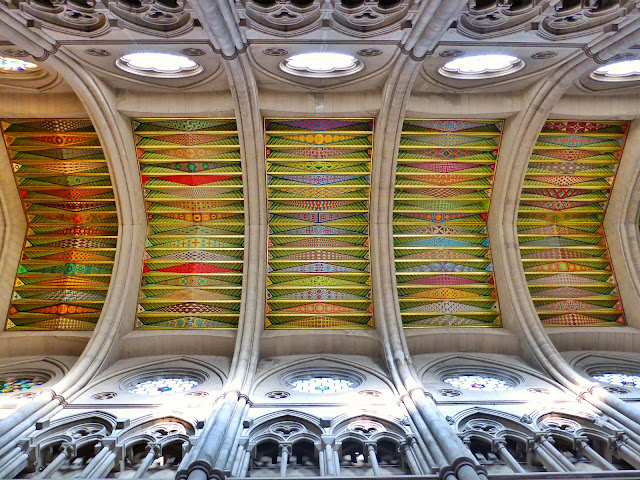
I then visited the Cathedral of Almudena, adjacent to the Royal Palace. I caught the mass and enjoyed stunning contemporary stained glass and artwork. The ceiling was a remarkable series of rectangles that contrasted with the soaring arches and curves of the cathedral.
And, in a reminder of how religion is so often a double edged sword for many, I noticed a prominent statue of Josemaria Escriva who was canonized very quickly this past century for founding the Opus Dei group. For many, he was a source of inspiration; for others, he represented a repressive figure. It was like my day trip to Avila where I saw good and bad in one place.
My next day in Madrid I visited the Royal Palace. The grounds were large and expansive, and one could imagine military brigades flexing ostentatiously in the square. The interior was lavish and laden with gold, as expected.
Most importantly for me during my two full days in Madrid was the visit to the Prado Museum. I actually went to the museum twice during those two days because there was so much to see and soak in. I caught a marvelous exhibition on El Greco, an artist who had always seemed to be far ahead of his time. I found the Hieronymus Bosch paintings, especially the Garden of Earthly Delights, to be enthralling.
Thematically, I couldn't help but notice the number of Madonna of the Milk paintings. The following was particularly surprising, as the baby Jesus coaxed Mary to feed Saint Bernard of Cluny.
The other consistent artistic style I saw was that the Prado's collection was decidedly melodramatic. It was as though the statues and paintings were in perpetual Lent mode, with beating of chests, tele-novelo level intensity, and obvious heart on the sleeve emotions (literally, many hearts right on those sleeves, as well as tables, and in mouths).
It made me wonder about the Spanish culture in general, whether as a people they found greater satisfaction with overt emotional affectation. It was sort of the polar opposite to the cool, detached British Museum.
I ended my stay in Madrid with walks through the city and Retiro Park. I saw beauty, families, sunset, and majestic architecture.
As I prepared to go home, I gave thanks for the time, resources, and generosity of all who supported me. I prayed for those who contributed to the Episcopal Relief and Development organization, a group for whom I sought to raise funds and make a donation during this pilgrimage. I had lit candles for my parents who inspired me to find God and growth throughout the world. I gave thanks for my new husband who supported me on this journey with such tremendous love that I get tearful thinking about it.
And I praised our Creator, who gave us vision, desire, and courage to find our way, our road, our journey, no matter who difficult. In such a journey, I discovered light and relationships and values that might not have appreciated as fully before.
Let all who are thirsty come
Let all who wish receive the water of life freely
Amen. Come Lord Jesus. Amen
I return to a journey's end, a journey's birth, a journey's sunset, a journey's renewed life. I returned, I return, I will return.
Thursday, October 16, 2014
A Day in Segovia - Look up, Look up, Look up, Look down
I spent the whole day looking up it seems. Well, almost.
First, the bullet train that whisks you from Madrid to Segovia is fast enough to make you dizzy. Look down at the ground and, if you're prone to motion sickness as I am, you won't feel so good. Look up and you'll see a rapidly shifting landscape that slides by with breathless abandon.
Once there, I took a city bus to the centre of town and walked towards my first destination. Along the way, my keeps kept reaching up the hills towards the north, as I could clearly see the Cathedral that I will be visiting later in the morning.
And soon, as I approached my destination, I saw the 95 ft tall Roman aqueduct that, even 2000 years after construction, remain standing. It boggles the mind that something that old was still in perfect use up until the 19th century. Somehow, this 2/3 mile long giant of stone evaded earthquakes, fires, and war. Graceful arch after graceful arch, arch upon arch, this stands as a reminder of what we can accomplish despite the odds.
I then proceeded to the Alcazar, where I found an intact castle that stood proudly upon the hill. The lines were somewhat fairytale in shape but the surprise for me was inside.
As one who appreciates irony, I loved comparing the solid, stoic behemoth with the effervescent, transient mirage. The two seemed locked in an futile ballet, where one danced around, while the other was planted firmly in place.
And life is like that sometimes. Sometimes, we want to be on this wild adventure, a journey of space and time, but we are held down by our nature, by our being. Or worse, we are held down by those who hold us down.
But in this irony lies another irony. The cathedral is in fact built to cause its congregants to look upwards, to search the skies, to peer up at another realm. It might not be able to get there itself, but it's meant to help us imagine ourselves in the clouds on another level.
I returned to the aqueduct for a light lunch and figured out the mystery of the pig. In several places in the Alcazar and cathedral, I saw pig references. In the square by the aqueduct, I asked a friendly shopkeeper about this as I knelt down and peered at the various clay and ceramic animals. There, looking down at these figures, he explained that Segovia has a long history with the pig, and that it was a symbol of its commercial importance.
And so my time in Segovia was spent looking up, looking up, and looking up. And, when it came time to think of worldly things like souvenirs, it came time to look down, at the pig and remember the soil where my feet were planted.
And from there, I looked up once more and smiled.
First, the bullet train that whisks you from Madrid to Segovia is fast enough to make you dizzy. Look down at the ground and, if you're prone to motion sickness as I am, you won't feel so good. Look up and you'll see a rapidly shifting landscape that slides by with breathless abandon.
Once there, I took a city bus to the centre of town and walked towards my first destination. Along the way, my keeps kept reaching up the hills towards the north, as I could clearly see the Cathedral that I will be visiting later in the morning.
And soon, as I approached my destination, I saw the 95 ft tall Roman aqueduct that, even 2000 years after construction, remain standing. It boggles the mind that something that old was still in perfect use up until the 19th century. Somehow, this 2/3 mile long giant of stone evaded earthquakes, fires, and war. Graceful arch after graceful arch, arch upon arch, this stands as a reminder of what we can accomplish despite the odds.
I then proceeded to the Alcazar, where I found an intact castle that stood proudly upon the hill. The lines were somewhat fairytale in shape but the surprise for me was inside.
Most beautifully to me were the unending supply of sumptuous Andalusian-inspired ceilings. The craftsmanship was stunning, the colors intoxicating, and the patterns enchanting. I could barely tear my eyes away from those ceilings, and I'm grateful that none of those original designs were lost in the mist of time.
From the Alcazar, I explored the Cathedral. Again, looking up from the Plaza Mayor, I was gobsmacked by a lovely sight: several hot air balloons were floating just beyond and above the Cathedral. They were colorful and contrasted with the smooth colors of the cathedral stone.
As an amateur photographer, one couldn't ask for better photo opportunities.
From the Alcazar, I explored the Cathedral. Again, looking up from the Plaza Mayor, I was gobsmacked by a lovely sight: several hot air balloons were floating just beyond and above the Cathedral. They were colorful and contrasted with the smooth colors of the cathedral stone.
As an amateur photographer, one couldn't ask for better photo opportunities.
As one who appreciates irony, I loved comparing the solid, stoic behemoth with the effervescent, transient mirage. The two seemed locked in an futile ballet, where one danced around, while the other was planted firmly in place.
And life is like that sometimes. Sometimes, we want to be on this wild adventure, a journey of space and time, but we are held down by our nature, by our being. Or worse, we are held down by those who hold us down.
But in this irony lies another irony. The cathedral is in fact built to cause its congregants to look upwards, to search the skies, to peer up at another realm. It might not be able to get there itself, but it's meant to help us imagine ourselves in the clouds on another level.
I returned to the aqueduct for a light lunch and figured out the mystery of the pig. In several places in the Alcazar and cathedral, I saw pig references. In the square by the aqueduct, I asked a friendly shopkeeper about this as I knelt down and peered at the various clay and ceramic animals. There, looking down at these figures, he explained that Segovia has a long history with the pig, and that it was a symbol of its commercial importance.
And so my time in Segovia was spent looking up, looking up, and looking up. And, when it came time to think of worldly things like souvenirs, it came time to look down, at the pig and remember the soil where my feet were planted.
And from there, I looked up once more and smiled.
Tuesday, October 14, 2014
A Day in Ávila - How Do You Defend Your Beliefs?
What best defends your beliefs? A vigorous prosecution of those who disagree and attack those who are different? Or, by defining the strengths and values of your belief system?
In essence, that's what today felt like to me. Ávila is a wondrous, ancient city that is best known as the home of Saint Teresa of Ávila. Here she was born, wrote her books, and lived her life in faith. She was a reformer, a Carmelite nun, and a theologian of who garnered tremendous popular affection.
It's also the home of Tomás de Torquemada, the first Grand Inquisitor, and thus was ground zero of the Spanish Inquisition. Rather than winning over the population, he convinced monarchs Isabel and Ferdinand to declare the Alhambra decree that expelled the Jews from Spain. His remains were pillaged and possibly incinerated in an ironic auto-da-fé.
Both come from a town with lovely walls, romantic streets, and beautiful buildings. The contrast between these two people struck me strongly. It was almost jarring to walk these streets and think of the ways history swung in alternative directions here.
I doubt that I can do justice to this comparison without writing one or two dissertations. But I've admired Saint Teresa of Ávila since I was in CCD. She has a natural advantage in any comparison because of that affection. But in my heart of hearts, I also like to think that it's more compelling, more authentic, more sincere if you win people over and not compel them.
So now that my Camino walk has ended and my pilgrimage trip is nearing its end, I have to wonder how this lovely land could inspire such contrasting ways of encouraging faith. And I pray that more people follow the Camino, the Way of Saint James, with the heart of an apostle and the brains and mental prayers of Saint Teresa.
In essence, that's what today felt like to me. Ávila is a wondrous, ancient city that is best known as the home of Saint Teresa of Ávila. Here she was born, wrote her books, and lived her life in faith. She was a reformer, a Carmelite nun, and a theologian of who garnered tremendous popular affection.
It's also the home of Tomás de Torquemada, the first Grand Inquisitor, and thus was ground zero of the Spanish Inquisition. Rather than winning over the population, he convinced monarchs Isabel and Ferdinand to declare the Alhambra decree that expelled the Jews from Spain. His remains were pillaged and possibly incinerated in an ironic auto-da-fé.
Both come from a town with lovely walls, romantic streets, and beautiful buildings. The contrast between these two people struck me strongly. It was almost jarring to walk these streets and think of the ways history swung in alternative directions here.
I doubt that I can do justice to this comparison without writing one or two dissertations. But I've admired Saint Teresa of Ávila since I was in CCD. She has a natural advantage in any comparison because of that affection. But in my heart of hearts, I also like to think that it's more compelling, more authentic, more sincere if you win people over and not compel them.
So now that my Camino walk has ended and my pilgrimage trip is nearing its end, I have to wonder how this lovely land could inspire such contrasting ways of encouraging faith. And I pray that more people follow the Camino, the Way of Saint James, with the heart of an apostle and the brains and mental prayers of Saint Teresa.
Labels:
Avila
,
post-Camino
,
Saint Teresa
,
spain
,
Tomas de Torquemada
Monday, October 13, 2014
No more arrows - a Day in Salamanca
Conrad and I left Elias and Jakob at the hotel, so that they could walk to Finesterre while we took the bus. I then left Conrad at Finesterre as I returned to Santiago to catch the pilgrim's mass and take the night train to Madrid, connecting there, and heading towards Salamanca.
Salamanca has the 4th oldest university in the world. Not only is it filled with academic history, but was once considered to be the jewel of higher education. Today it remains a vibrant city with an impressive ecclesiastic history.
It's blessed with two cathedrals, one built adjacent and around the original cathedral. Unlike other building projects, the city chose to preserve the original cathedral and have it serve as a sort of mega-chapel to the new cathedral. The Gothic lines of the new cathedral contrast beautifully with the Romanesque architecture of the original building.
What most fascinated me about my stay in Salamanca wasn't the large number of young people. That's to be expected in a college town. No, what I found odd was that there were no scallop shells or yellow arrows to guide me around the city.
I had to find the hostal on my own. I had to find the gorgeous and youth-filled Plaza Mayor without staring at the sidewalk. I found the cathedrals and convents all without following another person walking with a backpack.
All this was a jarring return to normalcy, to a life where there are no directions, no guides, no signposts. You might know where you want to go, but it's a mirage. We depend upon a false sense of assurance that the signs will take us where we want. Even if we think we're following arrows, I've noticed on the Camino, there's no guarantee that you are heading in the right direction.
Did you see every sign?
Did you understand what the sign was trying to convey?
Were you too busy talking, taking photos, thinking about your hunger, nursing your blister to notice?
Did you forget you were supposed to be looking for those signs.
All that is while we are actually on the Camino. But like life, when we're not on the Camino, we have to try even harder, to discern, to listen, to see, to grasp.
With the people I met and walked with, we talked much about being present. The Camino forces you to be present in the moment. Life gives you all too many ways to be detached, to float away, to stare at your phone. None of these are meant to keep you present but are meant to take you to a different realm.
And if we're trying to find our destination, the place we feel we want to be, how will that be possible if we escape the notion of now?
I marveled at the beauty, the food, the vibrancy of this wonderful city. And I felt uneasy at how difficult and tenuous it was to know where I was so that I could know where I wanted to be.
Friday, October 10, 2014
Camino - Practical Questions I've Been Asked by Those Who May Walk the Camino
Frequently Asked Questions
These are questions I've been asked since my return. This list will be edited as the questions keep popping up so feel free to bookmark it and return.Did you use a guidebook?
Most Americans use the following guidebook: A Pilgrim's Guide to the Camino de Santiago by John Brierley. We truly depended on this book. As such, we love John Brierly and also want to smack him on the side of the head when he's wrong and your feet hurt.
Where do you start?
Most start in St Jean Pied-de-Port on the French border and follow what historically is called the Camino Frances. It goes through a pass in the Pyrenees Mountains. You will literally be exposed to French, Catalan, Castillian, and Galician cultures doing this 800km (500 mile) walk. Because of my time limits, I started in Burgos. There's a direct bus that goes from Madrid's airport to Burgos. The village Terradillos de los Templario, a short bus ride from Burgos, is exactly half way along the Camino Frances.
You get to SJPP and the French border most easily by flying into France and taking a train. There are daily trains from Paris.
Do I need to climb mountains?
It depends on where you start and what you consider to be mountains. If you start in St Jean Pied-de-Port you are definitely heading through the Pyrenees. According to the most common guide book that Americans use (John Brierley), that first day is a rise from 200m (650ft) to 1400m (4750ft). Further on, heading up into Foncebadon where the Cruz de Ferro is placed, you are up at above 1500m (5000 ft). Both of these are gradual over the course of a day. In Galicia you face a steep climb in a short distance at O Cebreiro. It rapidly rises from 600m (1970ft) to 1300m (4265ft) in just 8km. Though this is stunningly beautiful, it's the steepest stretch.
At no point do you need mountain climbing equipment. I did all this with my hiking sandals and a hiking pole.
Is it blazing hot?
It depends on the time of year and where you start. The weather is comparable to higher altitude Southern California. If you go in June-August, expect it to be quite hot after 11am. It's a reason why many people prefer to start their day at 6am: by leaving early, you can finish before or rest during the hottest time of the day. I just went in September. It was wonderfully nice in Burgos, but when you are out on the meseta without any trees, it sure feels a lot hotter than it actually is. A 27C (80F) day might seem comfortable but bring lots of water. By the time I got to the rolling hills and the mountains, it got chilly at night but it would warm up to a nice cool, breezy day.
In the winter, it snows. It won't be hot.
Lastly, it rains for no reason whatsoever at any point, especially in the mountains. Spain juts into the Atlantic and when the rain clouds want to come in, they just come in.
Are there places to stay every 4-6 hours?
The Brierley book shows popular places to stay and there are more that it does not list. Places to eat and stay are almost always within two at most three hours walk at my pace of 5.5 kph. A typical pace of 4kph will put you within food and shelter at 3-4 hours at most. What will vary is the type of accommodations you will find.
What are these accommodations?
These are the four levels of accommodations that I found and used:
- Albergue - dormitory bunk-beds, co-ed rooms, sometimes co-ed bathrooms and showers (private stalls). These are usually 5-10euro (slightly cheaper if you go to the municipal ones versus the privately run ones). They are similar to youth hostels because they are usually closed from 8am-1pm so that they can clean the facility. Most have kitchens that you can use to cook your food. Many offer three course dinners with wine for under 10 euro. Many have washers and dryers for a 3-5 euro fee each. Most now try to give many electrical outlets to charge your devices. Bring a sleeping bag or a bag liner because the pillowcase and liner they provide are pretty useless.
- Hostal - inexpensive motel or possible rooms within someone's home. These are private rooms. They almost always have a private bathroom. The price ranges from 25-50 euro.
- Hotel - Full service hotels like anywhere in the world. Prices start at 50 euro.
- B & B - I found a lovely B&B in Villafranca del Bierzo. I had a private room but shared the bath and the breakfast and living room areas were wonderful.
And don't forget, you can always share the hostal, hotel, and B&B with new friends. That can cut the cost.
Tell me about the stamps?
Order your credentials (a sort of passport) in advance for free at http://www.americanpilgrims.com/camino/credential_req.html . You will bring these credentials with you and get it stamped wherever you stay and eat. You can also buy one at the starting city, but it's much easier and free to get it in advance so that you don't spend your trip abroad searching for an office that might be closed depending on when you arrive. The one at Saint Jean Pied de Port is 1/4 mile up the hill from the church on the Rue de Citadelle, among many stores. The credentials there cost 3 euro.
Remember to get at least one stamp each day and two stamps each day during the last 60 miles. That's required to get the compostela (certificate of completion) in Santiago de Compostela at the end of the trip.
The office to get your compostela is on the south of the cathedral in Santiago de Compostela. When facing the front facade, go to the right side, towards the rear. You'll see the fountain and the stairs / entrance to the south transept. Turn right and it's a few doors down on the left. Expect a long line. There's much fewer people at 8am if you're willing to wait until morning to get your compostela.
How heavy is your pack?
They say to limit your pack to 10% of your body weight. Obviously if you're smaller or thinner, this makes it tougher. My pack started out at 27-lbs with water. I hated it. I started to leave things behind everywhere so that I wouldn't have to carry it.
So my suggestion is: whatever you think you want to bring, bring less. Cut the weight in half. Everything weighs more after hours of walking. Everything weighs more after they get moist from rain. Everything weighs more when you are thirsty and hungry. Everything weighs more when you get blisters. I truly want to bring only 15-lbs with water next time, as that is a far more comfortable weight for me.
What would you bring in your pack now that you know better?
I decided I just need two alternating sets of clothes for walking and one for in-town to sightsee and eat dinner. This is my list if there is no chance for snow:
- Small flashlight. I brought a rechargeable one because batteries weigh so much (I just recently found a rechargeable kind at the 99cents Only store. You squeeze it for a minute and it recharges. I wish mobile phones could be this easy!). If you go in the summer, you might not even need a flashlight, especially if you intend to start after 7am.
- 3 underwear, thigh length because it reduces male chaffing. Two hiking, one for in-town.
- 1 lightweight walking shorts
- 1 lightweight walking trousers (I might skip this because I never wore them, even in the rain).
- 2 walking shirts (athletic style so that they wick moisture easily and dry rapidly).
- 1 long sleeve lightweight warm shirt
- 4 pairs hiking socks. This could be three but I value socks far more than any other clothing on the Camino. My blisters will testify how a clean fluffy pair of socks can be wonderfully soothing. Hiking socks are thicker and fluffier. I found "worker's socks" at Big Lots at 2/$5 that work as well as the expensive $30 pairs at the camping stores.
- Safety pins (can keep things together AND be used with blisters)
- Medicine. (cold & diarrhea). Just enough for two days because there are pharmacies everywhere.
- Ibuprofen/Advil (I took it daily after every walk. I ached less and could walk around the village in comfort. If there's one suggestion I have for pain management, it's to take some just after you get to your accommodations. )
- Various size bandages, enough for emergencies since there are pharmacies everywhere
- A tiny tube of antiseptic cream like Neosporin
- Mobile device charger and a small converter. I have a multi-port USB charger that already has the European power outlet so don't need a converter.
- Earphones to listen to music on your device or earplugs if you don't like snoring
- For some, sleeping attire (if you're like me and just sleep in your underwear, you can just pull off your shorts in your sleeping bag and don't need this. I used shorts that could be swimming trunks so it served double duty.)
- flip flops or sandals
- A few clothespins
- A couple bungies and few carabiner clips
- Camera charger because a mobile phone cannot zoom enough to see distance. I have done the trip before so I won't be bringing a camera with me any more.
- For some, a very light journal if you don't journal on your smartphone
- 6 empty small, 6 empty medium, 6 empty large ziploc bags
- Water bottle with tube (much more convenient than having to reach around or take the bag off just to drink water)
- Rolled up water bottle - rolls up and most importantly, it lies flat on your bed so you can have a sip of water in the middle of the night and it won't roll onto the floor (or onto the lower bunk)
- Emergency pair of glasses
- Very light towel, perhaps microfiber
- Tooth brush, tooth paste, floss, nail clippers, loofa mit (nothing strips off dirt as quickly)
- Rosary
- Sleeping bag or liner (best if it's bedbug resistant - why take chances?!)
- Rain Cape (for you and the backpack)
Things you will be wearing and are not in the pack:
Things I won't bring again:
There are stores everywhere, especially pharmacies.
One tip that I think will help if you're starting at St. Jean Pied-de-Port is to check out the stores right next to the camino credentials office. The office is towards the top of the hill. Go to the church and head up the hill. It's 1/4 mile up the hill. Across the street is La Boutique du Pelerin (1 Place Floquet tel 05-59-49-12-77). You can email directioncompostelle@orange.fr and pre-order items. When I repeat my trip, I intend to leave my swiss army knife at home so as to avoid checking in luggage or airport security and simply buy one at the store when I get there.
I think 75% wore hiking boots, 20% wore sneakers, and 5% like me wore hiking sandals. No matter the shoe, make sure it has excellent support and tread. Your feet will swell up after so much walking so don't get anything that's already snug while wearing your thick socks. Get something that's 1/2 size larger.
Where do you fly?
If you are starting at St Jean Pied-de-Port, then you usually fly into Paris and take the train down. If you are starting anywhere in Spain, it's much easier to fly into Madrid. There are direct trains and buses directly from the airport. Whatever you do, don't start walking the full walk on the very next day. Take a day off or walk only a few miles the next day because you will likely have jet lag.
Is it scary?
The United States is a scary country. Spain is not scary. I felt perfectly safe. The scariest thing for me was reading in Burgos how some bishop recounted his arrival to the cathedral and, on his way, saw a pilgrim getting eaten by a wolf. Say what? Well, that was centuries ago, and while I definitely saw dogs, I saw no wolves. The dogs were more scared by you clanging your hiking pole than you are by them.
Also there was the senior citizen who hiked very quickly but actually dragged his feat. And he didn't use a flashlight. Imagine hearing in the dark "shoosh shoosh shoosh shoosh" coming ever closer to you. Other than images of a slasher movie on the meseta, that was about it.
Is it only for the religious?
It's for everyone. I'd say that 50% of the people had faith or spiritual-based reasons for their journey. Of the rest, I'd say 2/3 still had some questions or issues they were confronting: what do I do now that I've been laid off, It's my 50th birthday and I want to do something memorable. I don't want to go to university so what should I do, should I move to another city or country?
Is it lonely?
There are times when you walk alone for stretches. The longest stretch for me to be alone was about 3 hours. You do see people, though, as they walk by so it's up to you to decide whether to remain alone. I found it incredibly easy to chat with people. That might be biased because I am told I can have a lovely conversation in a room by myself.
The loneliest moment for me was when I was in a room full of people. I sat at a long table where the only English speaker was at the opposite end. Nobody at that table spoke English, French, or Spanish so I had nobody to talk to. The English speakers were mostly at other tables that were already packed. Admittedly, this gave me a great incentive to learn some German so that I could have a better chance next time.
Do I need to speak Spanish?
I can answer this in several ways.
Camino specific words that might help if you know spanish but never thought you'd be taking a pilgrimage:
What if there's no room at the albergue?
See if there's another one in town. If that's full, consider a hostal or walk to the next town. In September, I never had to walk to the next town or have to sleep outside.
What's the food like?
A pilgrim's menu is offered in many places and albergues. It costs around 8-10euro. It's a three course meal. The first course will be something like one of the following (or a choice of one of the following): mixed salad, spaghetti, soup. The second course will be something like one of the following (or a choice of one of the following): pork chop and fries; bacon, eggs, and fries; meatballs and fries; sandwich and fries; and of course, fries and fries. The last course is dessert where you get or choose: helado (ice cream), a piece of fruit, flan, cake. Bread and wine / beer / water comes with everything.
It's a good value. If you're not as hungry, you can order from the a la carte menu at a bar or restaurant. A bocadillo (sandwich) usually costs around 3-5 euro and are large and meaty. A tortilla usually means an egg omelette with potatos.
Walking around, you can grab an ice cream for 1-2 euro, a cafe or chocolate for 1-2 euro, a bottle of water (if for some weird reason there are no water fountains) for 1-2 euro, a soda pop for 1.5 to 2.5 euro.
There are cafes in the middle of nowhere. Bars and pubs are cheaper than restaurants. You will be charged for a seat outside on the terrazzo (usually 1-2 euro).
Credit cards?
Credit cards usually are taken at restaurants and supermercados but with a 10 euro minimum. Know your Pin number. If you don't have a Pin number, try just pressing the green RETURN button without a number. This usually works but some places (like the train and bus station) don't like this.
Albergues are cash only. You will need to carry enough cash to pay the albergues. ATM machines work with most US bank cards, but there is usually a transaction feel of 2-3%.
There is a credit card company called Capitol One that has a credit card without a transaction fee. Whether you use that company or another, remember to call the company and let them know the dates you will be traveling overseas and which companies you will be visiting.
Mobile Phones?
You can activate text, voice, and data with your own mobile company to work abroad. This is usually expensive. If you have T-Mobile, the regular subscription allows you to use the phone internationally. Confirm with them that they still have this feature.
If you have another phone carrier, or if you want a less expensive option, have your phone unlocked by them. This isn't a mechanical lock. They can lock and unlock your phone remotely. USA mobile phones are often locked by default. Once unlocked, you can buy a mobile phone SIM card at the airport or in town in Europe. Common phone carriers in Spain are Orange, Vodafone, and MoviStar. For the price of 25-40$US, you can get a couple GB of data, free text, and discounted voice for a month. If you're walking for longer than a month, you just renew.
Wifi ("Is there Wifi" is "Hay Wifi" and pronounced "I weefee") is available in many restaurants and now at most albergues. Notable exceptions are in tiny villages like Foncebadon where there is no wifi anywhere.
- one or two hiking poles
- hiking shoes or sandals
- 1 wide brimmed hat
- 1 scarf for your neck if you burn easily or sweat a lot
- Mobile device (if you want it like I do)
- Camera (a mobile camera can't zoom well enough yet but when they do, I won't mention this). I won't bring one anymore since I've done the trip before.
- The clothing you are wearing that day
- A small very light day pack/purse. I used it to bring my valuables with me to dinner so that I wouldn't leave the passport and money alone in the albergue. Better safe than sorry.
- A lightweight mesh bag. This was useful to carry laundry that needed to dry a few hours more in the sun and air
- Swiss army knife. I used it to cut food and open wine bottles. I learned this when I backpacked through Europe in my college days: nothing is as delightful as having a picnic at a park or stream with just some water, If you bring your pack as a carry-on, you cannot bring this on the plane. You will need to buy it after you leave the airport. Otherwise, it goes in the checked luggage.
Things I won't bring again:
- iPad. I brought it in case of a work emergency. Many places have computers. This was silly of me and showed how my nervousness kept me from trusting the Camino. Learn to trust that you will be fine and you will be much happier.
- Cold and flu medicine - there are pharmacies on every block in every city and usually one every few villages
- So many bungees
- Plastic bags. You can get plastic bags at the grocery store
- Spoon and fork. The knife acts as a fork. As for a spoon, I didn't buy anything to eat that needed a spoon so I left it behind at some albergue.
- Sunglasses. The hat was sufficient and it felt less personal when talking to people.
- Shampoo - and maybe even soap. We're obsessed with this stuff. Our hair doesn't need to be shampooed daily. It's under a hat most of the day. As for soap, unless you're wallowing in the mud, most of the stuff just rinses off. I had one tiny soap bar that I used with the loofa and it was more than fine.
- Laundry detergent. I'll bring it but definitely just a small amount because you don't need much just to wash sweat and dust off. Most of the time, shampoo and ordinary soap are sufficient.
- Inflatable pillow. Every place had a pillow. And even if they didn't I could have just rolled up my jacket and it would have been fine.
- Wind-breaker. The rain cape was fine
- Lip balm. It was drizzly often so my lips were fine. If I needed it I could buy it
- Vaseline. My feet were sweaty all day so had no need for it after all. .If I needed it I could buy it.
- Hair gel. Seriously, nobody expects you to look good on the camino. Buy some at the end of the trip if you really need it.
- Big honking power strip. I need to buy a small plastic gadget that splits power to multiple outlets. I brought this thing because it's what I always bring to Europe on business trips. Well this isn't a business trip and it weighed 1/2 kg when a small splitter would weigh a couple ounces. It was handy but not worth the weight.
- Umbrella. It was handy once I got to the village, but I could have lived without one until after the trip.
- Coins. Coins weigh a lot. We Americans often pay with dollar bills, but they have 1 and 2 euro coins that weigh a ton. Use them up before reaching for a 5 euro bill.
- The guidebook. Next time I'm going to just scan the stupid thing and keep it on my phone because it weighs so much. I did that for the most part anyway. I would just photograph the next few pages of my journey, delete the old pages, and use that so that the book wouldn't get wet while walking.
- Electronics. I brought many more wires than needed just in case I left things behind. As though there aren't electronic and mobile phone stores in Spain.
Last minute items?
One tip that I think will help if you're starting at St. Jean Pied-de-Port is to check out the stores right next to the camino credentials office. The office is towards the top of the hill. Go to the church and head up the hill. It's 1/4 mile up the hill. Across the street is La Boutique du Pelerin (1 Place Floquet tel 05-59-49-12-77). You can email directioncompostelle@orange.fr and pre-order items. When I repeat my trip, I intend to leave my swiss army knife at home so as to avoid checking in luggage or airport security and simply buy one at the store when I get there.
What shoes did you wear?
Where do you fly?
If you are starting at St Jean Pied-de-Port, then you usually fly into Paris and take the train down. If you are starting anywhere in Spain, it's much easier to fly into Madrid. There are direct trains and buses directly from the airport. Whatever you do, don't start walking the full walk on the very next day. Take a day off or walk only a few miles the next day because you will likely have jet lag.
Is it scary?
Also there was the senior citizen who hiked very quickly but actually dragged his feat. And he didn't use a flashlight. Imagine hearing in the dark "shoosh shoosh shoosh shoosh" coming ever closer to you. Other than images of a slasher movie on the meseta, that was about it.
Is it only for the religious?
It's for everyone. I'd say that 50% of the people had faith or spiritual-based reasons for their journey. Of the rest, I'd say 2/3 still had some questions or issues they were confronting: what do I do now that I've been laid off, It's my 50th birthday and I want to do something memorable. I don't want to go to university so what should I do, should I move to another city or country?
Is it lonely?
There are times when you walk alone for stretches. The longest stretch for me to be alone was about 3 hours. You do see people, though, as they walk by so it's up to you to decide whether to remain alone. I found it incredibly easy to chat with people. That might be biased because I am told I can have a lovely conversation in a room by myself.
The loneliest moment for me was when I was in a room full of people. I sat at a long table where the only English speaker was at the opposite end. Nobody at that table spoke English, French, or Spanish so I had nobody to talk to. The English speakers were mostly at other tables that were already packed. Admittedly, this gave me a great incentive to learn some German so that I could have a better chance next time.
Do I need to speak Spanish?
I can answer this in several ways.
- No. You can get for the most part with English, though you will likely just be pointing at the menu.
- Yes, you will be far better off if you speak some Spanish.
- Definitely yes if you want to understand what they're saying to make decisions about where to stay.
- Not as much if you can speak French, German, Italian, or Portuguese.
Camino specific words that might help if you know spanish but never thought you'd be taking a pilgrimage:
- Backpack - mochila
- Walking Stick - bastón
- Blister - ampolla
- Foot -pie
- Leg -pierna
- Pain - dolor
- Medicine - medicina
- Pharmacy - farmacia
- Doctor - doctor
- Vegan - vegano
- Gluten-free - sin gluten
- Vegetarian - vegetariano / sin carne
- Normal Water - agua sin gas
- Toilet - baño / servicios / lavabos / aseos
What if there's no room at the albergue?
See if there's another one in town. If that's full, consider a hostal or walk to the next town. In September, I never had to walk to the next town or have to sleep outside.
What's the food like?
A pilgrim's menu is offered in many places and albergues. It costs around 8-10euro. It's a three course meal. The first course will be something like one of the following (or a choice of one of the following): mixed salad, spaghetti, soup. The second course will be something like one of the following (or a choice of one of the following): pork chop and fries; bacon, eggs, and fries; meatballs and fries; sandwich and fries; and of course, fries and fries. The last course is dessert where you get or choose: helado (ice cream), a piece of fruit, flan, cake. Bread and wine / beer / water comes with everything.
It's a good value. If you're not as hungry, you can order from the a la carte menu at a bar or restaurant. A bocadillo (sandwich) usually costs around 3-5 euro and are large and meaty. A tortilla usually means an egg omelette with potatos.
Walking around, you can grab an ice cream for 1-2 euro, a cafe or chocolate for 1-2 euro, a bottle of water (if for some weird reason there are no water fountains) for 1-2 euro, a soda pop for 1.5 to 2.5 euro.
There are cafes in the middle of nowhere. Bars and pubs are cheaper than restaurants. You will be charged for a seat outside on the terrazzo (usually 1-2 euro).
Credit cards?
Credit cards usually are taken at restaurants and supermercados but with a 10 euro minimum. Know your Pin number. If you don't have a Pin number, try just pressing the green RETURN button without a number. This usually works but some places (like the train and bus station) don't like this.
Albergues are cash only. You will need to carry enough cash to pay the albergues. ATM machines work with most US bank cards, but there is usually a transaction feel of 2-3%.
There is a credit card company called Capitol One that has a credit card without a transaction fee. Whether you use that company or another, remember to call the company and let them know the dates you will be traveling overseas and which companies you will be visiting.
Mobile Phones?
You can activate text, voice, and data with your own mobile company to work abroad. This is usually expensive. If you have T-Mobile, the regular subscription allows you to use the phone internationally. Confirm with them that they still have this feature.
If you have another phone carrier, or if you want a less expensive option, have your phone unlocked by them. This isn't a mechanical lock. They can lock and unlock your phone remotely. USA mobile phones are often locked by default. Once unlocked, you can buy a mobile phone SIM card at the airport or in town in Europe. Common phone carriers in Spain are Orange, Vodafone, and MoviStar. For the price of 25-40$US, you can get a couple GB of data, free text, and discounted voice for a month. If you're walking for longer than a month, you just renew.
Wifi ("Is there Wifi" is "Hay Wifi" and pronounced "I weefee") is available in many restaurants and now at most albergues. Notable exceptions are in tiny villages like Foncebadon where there is no wifi anywhere.
Labels:
Camino de Santiago
,
caminodesantiago
,
caminomel
,
faq
,
preparation
,
preparing
Thursday, October 9, 2014
Day 16 - The Botafumeiro
So...
This happened
(Friday September 26, after the 7:30pm mass in the Cathedral of Santiago de Compostella)
From Wikipedia
One tradition has it that the use of a swinging censer in the Santiago de Compostela Cathedral began in the 11th century. Arriving pilgrims were tired and unwashed. It was also believed that incense smoke had a prophylactic effect in the time of plagues and epidemics. Of course, incense burning is also an important part of the liturgy, being an "oration to God", or form of prayer.
Many other cathedrals had similar large thuribles at one time. However, most of the other cathedrals discontinued the use of their swinging censers over the years.
Friday, October 3, 2014
Camino Conference Call
An odd thing happened yesterday at one of my meetings. It was the first work meeting with my technical crew since returning from the Camino. It's a conference call, because like most high tech places, we're in distant locations and can function easily in virtual offices.
The meeting went well and at the end, before I closed the meeting, I just started speaking from the heart. I'm not sure what prompted me to say these things, as it was definitely off topic. I described how I started the Camino expecting to walk alone most of the time. I assumed that the hours of walking in the sun, rain, and everything in between would be largely in isolation, with little interaction with others.
And, as I mentioned in these blog postings, I was completely wrong.
In fact, I spoke with countless people, many more than I described in the blog. Moreover, it was these very contacts that made the Camino so worthwhile, so memorable, so alive for me. It was these very interactions, so casual yet so meaningful, both ephemeral and yet so deep, that instilled upon me a profound appreciation for what a pilgrimage can do to you. I was connected with everyone, and my journey was better because of this. I would have failed if it were otherwise.
After describing this, I pointed out that when I started the company almost 20 years ago, I expected to be alone. I was a consultant and didn't need to collaborate with others. I'd work alone at my desk or at someone's office, with no need for working with others who weren't the actual customers.
And I was completely wrong.
I depended on those I've hired, and our journey was all the better. I didn't know it when I started, but my commitment to them was every bit as strong as for a family member. And though it wasn't what I initially expected, I would have failed if it were otherwise.
I choked back the tears as I said these words of appreciation. And of course, thank you, readers and friends, for walking this Camino with me.
The meeting went well and at the end, before I closed the meeting, I just started speaking from the heart. I'm not sure what prompted me to say these things, as it was definitely off topic. I described how I started the Camino expecting to walk alone most of the time. I assumed that the hours of walking in the sun, rain, and everything in between would be largely in isolation, with little interaction with others.
And, as I mentioned in these blog postings, I was completely wrong.
In fact, I spoke with countless people, many more than I described in the blog. Moreover, it was these very contacts that made the Camino so worthwhile, so memorable, so alive for me. It was these very interactions, so casual yet so meaningful, both ephemeral and yet so deep, that instilled upon me a profound appreciation for what a pilgrimage can do to you. I was connected with everyone, and my journey was better because of this. I would have failed if it were otherwise.
After describing this, I pointed out that when I started the company almost 20 years ago, I expected to be alone. I was a consultant and didn't need to collaborate with others. I'd work alone at my desk or at someone's office, with no need for working with others who weren't the actual customers.
And I was completely wrong.
I depended on those I've hired, and our journey was all the better. I didn't know it when I started, but my commitment to them was every bit as strong as for a family member. And though it wasn't what I initially expected, I would have failed if it were otherwise.
I choked back the tears as I said these words of appreciation. And of course, thank you, readers and friends, for walking this Camino with me.
Thursday, October 2, 2014
Post Camino visits
Please stay tuned as I describe visits to
These were side visits that I was able to do because I padded my time away in case I got seriously delayed on the Camino.
I'm back in the states now, but will be posting how these particular cities played a part in my Camino experience.
Subscribe to:
Posts
(
Atom
)




